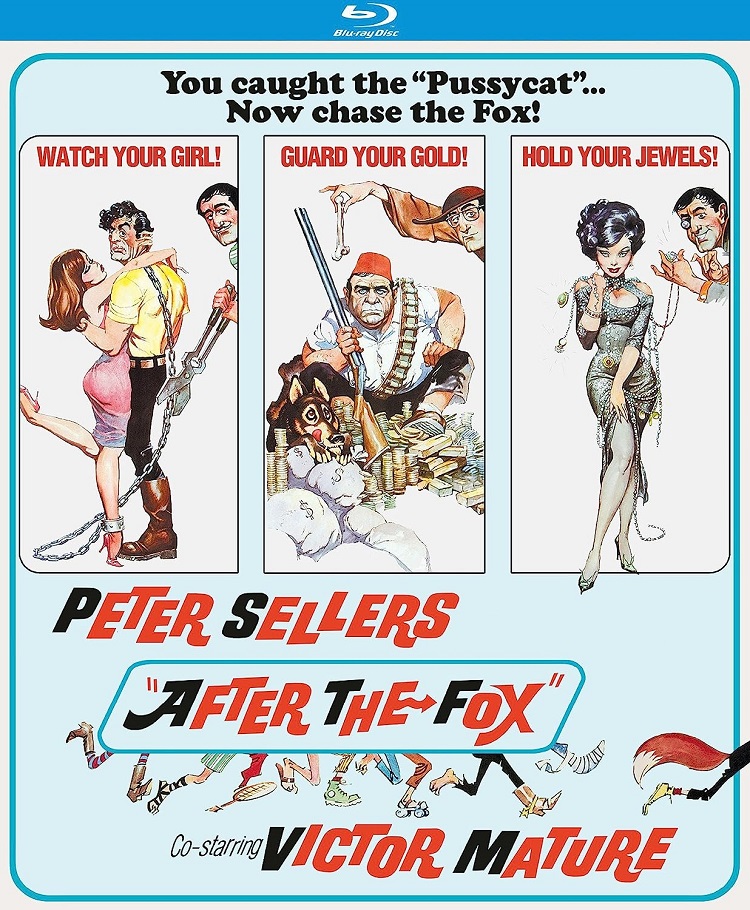
So, you’ve got one of the greatest Italian film directors of all time in Vittorio De Sica, one of the most beloved of all American playwrights in Neil Simon, and one of the chief members of the British comedy pantheon in Peter Sellers. This collaboration must be a surefire classic, or at the very least, a notable misstep among three sterling careers. Except, it’s not.
About the only thing remarkable about 1966’s After the Fox is how unremarkable the film is, despite the array of talent on hand. Did I mention it features a (maddening) theme song by Burt Bacharach and Hal David, sung by The Hollies and Sellers in character?
Marketed as a follow-up to the previous year’s Sellers-starring, Woody Allen-penned What’s New, Pussycat, After the Fox combines winking Italian sex comedy (a genre De Sica flirted with in the later stages of his career) and showbiz farce in an ill-conceived marriage that’s too shaggy and plodding to be disastrous. It’s Simon’s first screenplay, and he co-wrote it with De Sica’s longtime collaborator Cesare Zavattini.
There are conflicting desires at work here. On one hand, the film wants to give Sellers free reign to mug his way across Italy, but it also becomes increasingly concerned with becoming a very lame satire of arthouse cinema (think Michael Medved trying to skewer Last Year at Marienbad, and you’ll approach the level of discourse).
Sellers stars as Aldo “The Fox” Vanucci, a master criminal with the ability to convincingly portray any persona. It’s obvious where this is headed, and anyone who isn’t fond of Sellers’ master of disguise shtick is advised to check out now. Vanucci is convinced to break out of prison and lend his talents to a massive gold heist — not because of the money, but because his younger sister (Britt Ekland) might sully herself by becoming an actress and kissing men. Yes, it’s convoluted and also more than a little unpleasant.
The heist eventually revolves around Vanucci convincing an entire village that he is a famous director, in town to shoot a serious film about emotional alienation. (Cue Sellers scrunching up his face: “No matter how fast you run, you can never run away from yourselves!”)
Along with fooling the entire town into unwittingly participating in his robbery, Vanucci also convinces vain, washed-up movie star Tony Powell (Victor Mature) that he’s participating in a career rejuvenator. Mature’s unearned pomposity is easily the funniest thing in the film, particularly paired with Martin Balsam’s performance as his incredulous agent.
Of course, the whole thing looks polished under De Sica’s steady direction, which helps paper over the script’s rickety nature. Some people will undoubtedly find this all very funny, but that’s more the product of assembling lots of talent and tossing it all in a blender than any coherent comic vision.
Kino brings After the Fox to Blu-ray as part of its Studio Classics line. The 1080p, 2.35:1 transfer from the MGM library is pretty nice, offering reasonably vibrant color and a stable image for what is unsurprisingly grainy source material. Fine detail and sharpness are pleasing, if not mind-blowing, and damage can be persistent, particularly some heavy tramlines that crop up in the second half of the film. The 2.0 DTS-HD Master Audio soundtrack doesn’t have any major issues, though it can sound a bit harsh and overextended at times.
Aside from a trailer, the lone extra is a brief appreciation from Problem Child screenwriter Larry Karaszewski, who tends to overestimate some of the film’s gags. (See, I knew someone thought this movie was funny.)